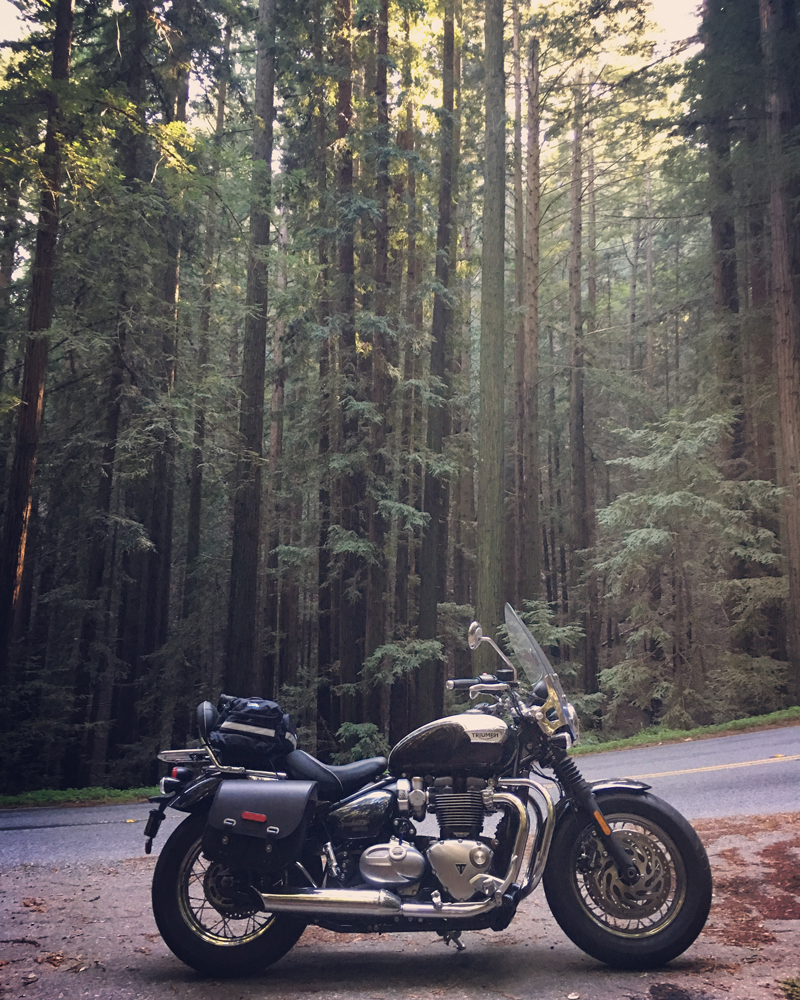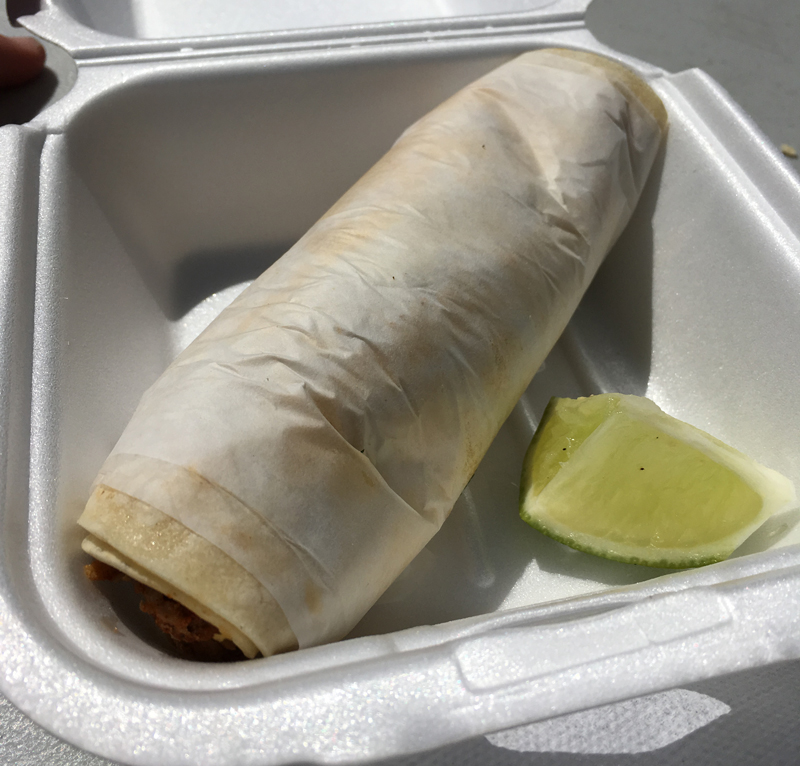Here at Rider (and WomanRider.com), we have an unofficial motto: “Ride to eat, eat to ride.” And I would contend that the perfect road food is the taco.
That’s right, the lowly taco, eaten by indigenous peoples in what is now Mexico since long before the Spanish arrived, bastardized (and popularized by Taco Bell) into the hard-to-eat, crunchy-shelled, ground beef, iceberg lettuce and yellow cheese-filled version most Americans are familiar with. There are Korean tacos (delish) and dessert “choco tacos” (also delish), but what I’m after is the authentic Mexican street food version: variations on a theme of meat, onions and cilantro served on a soft corn tortilla (well, two actually). Roll it together and nosh—gone in three or four bites.
Being the glutton that I am, I’ve been putting together food-based road trips for years. When I lived in Indiana it was BBQ and pork tenderloin sandwiches, in Rhode Island it was clam chowder (white, not red, and certainly not clear), in Colorado it was burgers and, in the fall, pork green chile stew. What I’ve discovered, however, is that while delicious and destination-worthy, none of these are truly good road foods.
Tacos, however, are small enough to stave off hunger without making you feel stuffed or sleepy; one is a snack, two is a bigger snack, three is a meal. You can grab one quickly and eat standing next to your bike. The best part is they’re packed with satisfying flavor—way better than a dry granola bar or greasy cheeseburger.

California, as you might expect, is replete with really good Mexican food, and you’ll find taco stands and taco trucks everywhere from urban street corners to the suburbs to the side of a random farm road. By the way, a helpful hint: where there’s agriculture, there are good tacos.
I recently took a 2018 Triumph Speedmaster on an 850-mile, two-night road trip up California’s Central Coast—what better opportunity to seek out the perfect example of the perfect road food? Caveat: I was starting in Ventura county, north of L.A., so I missed the myriad of tacos in San Diego and Los Angeles—another ride for another time!

My first night was way up in Santa Cruz county, south of the San Francisco Bay Area, so I hightailed it up U.S. Route 101—312 of my 850 miles in one fell swoop. I ducked off at San Miguel for gas and my first taco, at Taco Mafia, where I chose a carnitas taco ($3.00). Carnitas, which literally means “little meats,” originates from the Western Mexican state of Michoacán. Taco Mafia’s version includes tender chunks of pulled pork that are given a quick sear on the flat top for deliciously crispy edges, topped with onion, cilantro and a splash of salsa verde.

Farther north, the landscape opened up into the wide, flat Salinas Valley, and the breeze off the ocean cooled me down after the warmer inland temperatures. The Salinas Valley grows the produce that feeds America, and I know that means the odds of a good taco are high. I was right.
Castroville bills itself “The Artichoke Center of the World,” but it’s also the home of one of my new favorite tacquerias, Deliciosos Tacos. Wedged into a decrepit strip center next to an equally questionable-looking Chinese restaurant, this is the kind of place where all the signs are in Spanish and only cash is accepted.

Do yourself a favor and order a taco al pastor. Your $2.00 will buy you flavorful chunks of pork swimming in a tangy red sauce, onion, cilantro and half a pickled jalapeno, all on top of two corn tortillas (you specify white or yellow). Say gracias and walk outside to eat it in the sunshine.
Al pastor, which means “shepherd style,” has interesting origins. As a style it developed in Central Mexico, based on the shawarma-style grilling technique brought to Mexico by Lebanese immigrants in the late 19th and early 20th centuries. The pork is marinated in chiles, spices and pineapple, then layered vertically on a rotating spit and once cooked is sliced off with a big knife—the same technique used for Greek gyros. Tacos al pastor tend to vary widely from tacqueria to tacqueria; in some areas of Mexico, they are called tacos de adobada or tacos árabes (Arab tacos).
My destination that first night was an adorable organic farm-turned-B&B, Flipjack Ranch, north of Santa Cruz deep in the redwood and pine forest. I had one last taco stop for the day, however, and it turned out to be the biggest disappointment of the trip. Taqueria los Pericos’ carne asada—which translates to “grilled meat”—“super soft taco” ($4.75) was a white college student’s idea of a great taco: heaped with strips of flavorless beef, iceberg lettuce, sour cream, guacamole and a scattering of jalapenos and tomatoes. It was way too big to pick up and eat, which kind of ruins the whole point of tacos as a street food.

Disappointed in my taco but excited for the upcoming roads, I headed north on State Route 9. Route 9 is just one of dozens of insanely twisty roads that crisscross the Santa Cruz Mountains, but as a major route between the Bay Area and Santa Cruz, it unfortunately carries quite a bit of traffic. The locals drive fast, but vacationers in lumbering RVs don’t…and both tend to “take their half out of the middle,” crossing the centerline regularly, so keep to the right side of your lane.

At Boulder Creek I hung a left on State Route 236 towards Big Basin Redwoods State Park. If you’ve got the time, it’s well worth a stop to hike off your tacos and get up close and personal with the mighty redwoods. I’m here to ride, though, so I continue past the main visitor center and make my way carefully deeper into the park. The road narrows considerably—often only a lane wide—so take it slow and enjoy the scenery.

Back on Route 9, it’s time to meander towards Flipjack. Following roads with names like Felton Empire and Ice Cream Grade, I eventually turn onto a dirt driveway (totally doable on the Speedmaster) and find myself in front of the Flipjack ranch house. Owners David and Robin have traveled the world on a motorcycle (their next destination: Vietnam) and bought the ranch five years ago. They raise turkeys, goats, ducks, chickens and rabbits, plus a variety of fruits, veggies and herbs that are all used in the food they prepare for their guests.

Apart from the four rooms, they also have a camping area (a family of four from the Bay Area were camping there when I stayed) and several tent cabins tucked away into the forest. There’s even a magical treehouse built into a stand of massive redwoods; your breakfast is sent up to you via a cable and pulley-powered tray!

Flipjack would make a fantastic base for exploring the many twisty roads in the area, but time is short for me so I head out the following morning and aim my front wheel south. It’s bittersweet—as much as I’d like to explore more, I’m excited to revisit Big Sur, which I haven’t ridden since before the landslides in winter of 2016 closed Highway 1 in two places, eliminating or complicating access to the most popular areas.

This epic (yes, the word is applicable in this case) ride will start taking your breath away shortly after leaving the town of Carmel-By-The-Sea, and it doesn’t let up until you’re forced to detour shortly after Limekiln State Park. With the southern access still closed, traffic was lighter than normal for me; usually it’s clogged with tourists. Take your time and stop often for pictures and just to admire the scenery. Big Sur is justifiably famous worldwide. Enjoy it!

After detouring off Highway 1 to avoid the last remaining road closure near Gorda, I looped back around and rejoined it in the village of Cambria. Nestled in the hills among coastal pine and cypress trees, Cambria is an ideal southern base for a Central Coast ride.

Every business, including the hotels, is locally owned; stay in the village at one of the B&Bs or quaint, historic motels such as the Bluebird, where it’s easy to walk to restaurants, bars, coffee shops and the many antique stores. Or settle in at one of the hotels lining Moonstone Beach Road; I stayed at El Colibri Hotel & Spa, which is at one end of the Moonstone Beach boardwalk.

Whatever you do, don’t miss the opportunity for yet another taco tasting, at Boni’s Tacos, a true hole-in-the-wall tucked away in an industrial park on a dead end road. Interested in this little family-run joint’s interpretation, I went for another taco al pastor ($3.25). Boni’s version topped the pork, onion and cilantro with pineapple—a common variation—and it came rolled in wax paper with a lime wedge on the side. Delicious!


The next morning, after a freshly roasted cuppa joe at the Cambria Coffee Roasting Company, I meandered inland to Atascadero—out of my way, yes, but I couldn’t ride within 20 miles of Garcia’s and not stop.
We discovered Garcia’s on a recent ride, and the tacos de adobada ($3.50) were good enough to be crave-inducing. It’s hard to imagine a bard writing songs about a taco, but these might be ballad-worthy. The chile/vinegar-based adobo marinade drips down your hand as you bite in, and you’ll pick up on the unusual, warm flavors of allspice, cinnamon, cloves and nutmeg—my guess is the Middle Eastern influence on many adobada recipes. It’s topped with sautéed onions, cilantro and a sour cream/avocado/salsa verde sauce.


Back to the coast for one last taco, a very important style to California in particular: the taco de pescado, or fish taco. Originating in Baja, fish tacos can use either grilled or fried fish, and are usually topped with lettuce or shredded cabbage, pico de gallo, and sour cream or a citrus/mayo sauce.
Ruddell’s Smokehouse in Cayucos serves up its own unique variation of the fish taco: smoked fish. I opted for the smoked albacore ($6.00), which was topped with a cool, crunchy relish of celery, apples, lettuce and tomato, and some sort of creamy, citrusy sauce. Very unique, and quite tasty!

As I wound my way home on Highway 1, I reflected on how lucky I am to live in a place with such diverse and delicious food, ideal weather, spectacular scenery and entertaining roads. It all makes my life-long search for the perfect taco that much more enjoyable.















Ya had me at Ride To Eat. Sounds to me like a perfect ride. Great food, scenery and roads.
On your next ride, open it up for other girls to join you.
The more girls on bikes the better!
Good idea! -Jenny
Great article about a great trip. Thanks for including the photos and links.
Excellent. Fun read. Enjoyed the ‘ride’.
Any comments on the choice of livery you rode on this trip . Since this is a relatively new model to the Triumph line. Maybe a mini review here in comments on the why of it for this choice. Many Triumph fans out here that ride both Beemers and Bonnies. cheers
Good question. I’m actually planning to write up a road test review shortly. In brief, the Highway kit turns the Speedmaster (the First Ride Review is on this site) into a comfortable light tourer. My only complaint is the beach bar, which put my wrists at an uncomfortable angle. I’d swap the bar for a straighter one, or at least one without the backwards bend, and it would be much more comfortable for multiple long days in the saddle. -Jenny
Ruddell’s was a great choice, but Taco Temple in nearby Morro Bay deserves a try on your next trip.
Duly noted! -Jenny
Sounds like a great trip.
Do you have a small map outlining your route?
OK, so a few of you have asked for a map of my route. (Yay, I’m glad you love tacos as much as I do! OK…and probably great roads too.) Here are some Google Maps links that show my route and taco stops:
Day 1: https://goo.gl/maps/6KZz7d54BmQ2
Day 2: https://goo.gl/maps/ngrkc3biwEz
Day 3: https://goo.gl/maps/os19KKj4APt and then from here I just took Highway 1 back to Camarillo!